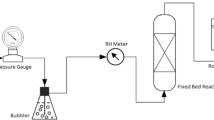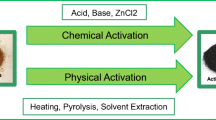Abstract
This study examined the effect of potassium permanganate (KMnO4)-modified activated carbon for formaldehyde removal under different face velocities and different initial formaldehyde concentrations in building environment. We chose the coconut shell activated carbon due to their high density and purity. Moreover, they have a clear environmental advantage over coal-based carbons, particularly in terms of acidification potential. The chemical properties were characterized by FTIR to show the functional groups, EDS to calculate each component of their energy bands to know how the ratio is. Also, the morphology of the surface was examined with scanning electron microscopy (SEM). The BET determines specific surface area, pore size, and pore volume. It was found that where the initial formaldehyde concentration and the face velocity are low, adsorption capacity is high. The adsorption isotherms of formaldehyde on modified activated carbon are well fitted by both Langmuir and Freundlich equations. The rate parameter for the pseudo-first-order model, pseudo-second-order model, and intraparticle diffusion model was compared. The correlation coefficient of pseudo-second-order kinetic model (0.999 > R2 > 0.9548) is higher than the coefficient of pseudo-first-order kinetic model (0.5785 < R2 < 0.8755) and intraparticle diffusion model (0.9752 < R2 < 0.9898). Thus, pseudo-second-order kinetic model is more apposite to discuss the adsorption kinetic in this test, and the overall rate of the modified activated carbon adsorption process appears to be influenced by more than one step that is both the intraparticle diffusion model and membrane diffusion.



















Similar content being viewed by others
References
Afkhami A, Bagheri H, Madrakian T (2011) Alumina nanoparticles grafted with functional groups as a new adsorbent in efficient removal of formaldehyde from water samples. Desalination 281:151–158
Alben KT, Jacobs S (1986) Trace element distributions of a granular activated carbon. Carbon 24(2):177–183
ANSI/ASHRAE Standard 145.1 (2008) ASHRAE, Inc., Atlanta
Ayrilmis N, Lee YK, Kwon JH, Han TH, Kim HJ (2016) Formaldehyde emission and VOCs from LVLs produced with three grades of urea-formaldehyde resin modified with nanocellulose. Build Environ 97:82–87
Boehm HP (2002) Surface oxides on carbon and their analysis: a critical assessment. Carbon 40(2):145–149
Brasquet C, Le Cloirec P (1997) Adsorption onto activated carbon fibers: Application to water and air treatments. Carbon 35:1307–1313
Chen YQ, Wu RP, Ye XF (2012) Structural characterization and property study on the activated alumina-activated carbon composite material. Chin J Struct Chem 31:315–320
Cheng WH (2008) Adsorption Characteristics of Granular Activated Carbon and SPME Indication of VOCs Breakthrough. Aerosol Air Qual Res 8(2):178–187
Dehdashti A, Khavanin A, Rezaee A, Assilian H, Motalebi M (2011) Application of microwave irradiation for the treatment of adsorbed volatile organic com-pounds on granular activated carbon. Iran J Environ Health Sci Eng 8:85–94
Guibal E (1998) Metal-Anion Sorption by Chitosan Beads: Equilibrium and Kinetic Studies. Ind Eng Chem Res 37:1454–1463
He C, Guo B, Pei J, Chen W, Han KH, Zhang J (2014) Testing and Evaluation of Filter Media Performance: Correlation between High and Low Challenge Concentration Tests for Toluene and Formaldehyde, 2014 ASHRAE Winter Conference. N Y 120:1–8
Ho YS, McKay G (1999) Pseudo-second order model for sorption processes. Process Biochem 34:451–465
Houshmand AH, Daud WMAW (2010) Study of Changes in a Palm-Shell-Based Activated Carbon Characteristics by Nitric Acid. J Appl Sci 10:1116–1121
Hu SC, Chang A, Shiue A, Lin T, Liao SD (2017) Adsorption characteristics and kinetics of organic airborne contamination for the chemical filters used in the fan-filter unit (FFU) of a cleanroom. J Taiwan Inst Chem Eng 75(6):87–96
Huang CC, Chen CH, Chu SM (2006) Effect of moisture on H2S adsorption by copper impregnated activated carbon. J Hazard Mater B 136:866–873
IARC Working Group (2006) IARC Monographs on the Evaluation of Carcinogenic Risks to Humans-Formaldehyde, 2-Butoxyethanol and 1-tert- Butoxypropan-2-ol. IARC, Lyon
Jiang CJ, Li DD, Zhang PY, Li JG, Wang J, Yu JG (2017) Formaldehyde and volatile organic compound (VOC) emissions from particleboard: Identification of odorous compounds and effects of heat treatment. Build Environ 117:118–126
Lahaye JQ (1998) The chemistry of carbon surfaces. Fuel 77:543–547
Lagergren S (1898) Zur theorie der sogenannten adsorption gelösterstoffe, Kungliga Svenska Vetenskapsakademiens. Handlingar 24:1–39
Lee KJ, Miyawaki J, Shiratori N, Yoon SH, Jang J (2013) Toward an effective adsorbent for polar pollutants: Formaldehyde adsorption by activated carbon. J Hazard Mater 260:82–88
Lu XC, Jiang JX, Sun K, Xie XP, Hu YM (2012) Surface modification, characterization and adsorptive properties of a coconut activated carbon. Appl Surf Sci 258:8247–8252
Mo JH (2009) Research on some key fundamental problems in the photocatalytic oxidation of indoor volatile organic compounds. Tsinghua University, Beijing
Mopoung S, Moonsri P, Palas W, Khumpai S (2015) Characterization and Properties of Activated Carbon Prepared from Tamarind Seeds by KOH Activation for Fe(III) Adsorption from Aqueous Solution. Sci World J. Article ID 415961.
Nelson GO, Harder CA (1976) Respirator cartridge efficiency studies: VI. Effect of concentration. Am Ind Hyg Assoc J 37:205–215
Piwonskia I, Kadziołaa K, Kisielewskaa A, Soliwodaa K, Wolszczakb M, Lisowskac K, Wronskac N, Felczakc A (2011) The effect of the deposition parameters on size, distribution and antimicrobial properties of photoinduced silver nanoparticles on titania coatings. Appl Surf Sci 257:7076–7082
Rengga WDP, Sudibandriyo M, Nasikin M (2013) Adsorption of Low-Concentration Formaldehyde from Air by Silver and Copper Nano-Particles Attached on Bamboo-Based Activated Carbon. International Journal of Chemical Engineering and Applications 4:332–336
Saeid A (2004) Kinetic models of sorption: a theoretical analysis. J Colloid Interface Sci 276:47–52
Saito Y, Nakano K, Shida S, Soma T, Arima T (2004) Microwave-enhanced release of formaldehyde from plywood. Holzforschung 52:548–551
Scahill J, Wolfrum EJ, Michener WE, Bergmann M, Blake DM, Watt AS (2004) A New Method for the Rapid Determination of Volatile Organic Compound Breakthrough Times for A Sorbent at Concentrations Relevant to Indoor Air Quality. J Air Waste Manage Assoc 54:105–110
Sekine Y (2002) Oxidative decomposition of formaldehyde by metal oxides at room temperature. Atmos Environ 36:5543–5547
Shin SK, Song JH (2011) Modeling and simulations of the removal of formaldehyde using silver nano-particles attached to granular activated carbon. J Hazard Mater 194:385–392
Shiue A, Hu SC, Chang SM, Ko TY, Hsieh A, Chan A (2017) Adsorption Kinetics and Breakthrough of Carbon Dioxide for the Chemical Modified Activated Carbon Filter Used in the Building. Sustainability 9:1533. https://doi.org/10.3390/su9091533
Shiue A, Hu SC (2012) Adsorption Kinetics for the Chemical Filters Used in the make-up air unit (MAU) of a cleanroom. Sep Sci Technol 47:577–583
Shiue A, Kang YH, Hu SC et al (2010) Vapor adsorption characteristics of toluene in an activated carbon adsorbent-loaded non-woven fabric media for chemical filters applied to cleanrooms. Build Environ 45:2123–2131
Stavropoulos GG, Samaras P, Sakellaropoulos GP (2008) Effect of activated carbons modification on porosity, surface structure and phenol adsorption. J Hazard Mater 151:414–421
Tang L, Li LQ, Chen RF, Wang CH, Ma WW, Ma XC (2016) Adsorption of acetone and isopropanol on organic acid modified activated carbons. J Environ Chem Eng 4:2045–2051
VanOsdell DW, Owen MK, Jaffe LB, Sparks LE (1996) VOC removal at low contaminant concentrations using granular activated carbon. J Air Waste Manage Assoc 46:883–890
Vimonses V, Lei S, Jin B, Chow CWK, Saint C (2009) Kinetic study and equilibrium isotherm analysis of Congo Red adsorption by clay materials. Chem Eng J 148:354–364
Wang Z, Zhong MG, Chen L (2016) Coal-based granular activated carbon loaded with MnO2 as an efficient adsorbent for removing formaldehyde from aqueous solution. Desalin Water Treat 57:13225–13234
Wang M, Zhang P, Li J, Jiang C (2014) The effects of Mn loading on the structure and ozone decomposition activity of MnOx supported on activated carbon. Chin J Catal 35(3):335–341
Weber W, Morris J (1963) Kinetics of adsorption on carbon from solution. Sanit Eng Div Am Soc Civ Eng 89(SA2):31–40
World Health Organization (2010) WHO Guidelines for Indoor Air Quality: Selected Pollutants. WHO Regional Office of Europe.
Xu B, Chen ZQ, Ma Q (2016) Effect of high-voltage electric field on formaldehyde diffusion within building materials. Build Environ 95:372–380
Yang P, Zhu XH (2016) Experimental research on microwave treatment to reduce formaldehyde from mediun density fibre board. J Build Mater 19:1102–1107
Yang YK, Zhang H, Jin SG (2011) A New Method of Activated Carbon Loading MnO2 to Formaldehyde Degradation. Adv Mater Res 332:1743–1746
Ye W, Zhang X, Gao J, Cao GY, Zhou X, Su X (2017) Indoor air pollutants, ventilation rate determinants and potential control strategies in Chinese dwellings: A literature review. Sci Total Environ 586:697–729
Yin CY, Aroua MK, Daud WMAW (2007) Review of modifications of activated carbon for enhancing contaminant uptakes from aqueous solutions. J Hazard Mater 52:403–415
Zhuang QL, Kyotani T, Tomita A (1994) DRIFT and TK/TPD Analyses of Surface Oxygen Complexes Formed during Carbon Gasification. Energy Fuel 8(3):714–718
Zou ML, Zou YP, Li XP, Wang LL (2016) Study on Adsorption of Formaldehyde by Modified Activated Carbon. Meteorol Environ Res 7:31–35
Funding
The authors would like to acknowledge the support from the Ministry of Science and Technology with contract number 106-3011-F-027-001 and Taiwan Hipoint Corporation in Taiwan.
Author information
Authors and Affiliations
Corresponding author
Additional information
Responsible editor: Tito Roberto Cadaval Jr
Rights and permissions
About this article
Cite this article
Hu, SC., Chen, YC., Lin, XZ. et al. Characterization and adsorption capacity of potassium permanganate used to modify activated carbon filter media for indoor formaldehyde removal. Environ Sci Pollut Res 25, 28525–28545 (2018). https://doi.org/10.1007/s11356-018-2681-z
Received:
Accepted:
Published:
Issue Date:
DOI: https://doi.org/10.1007/s11356-018-2681-z




